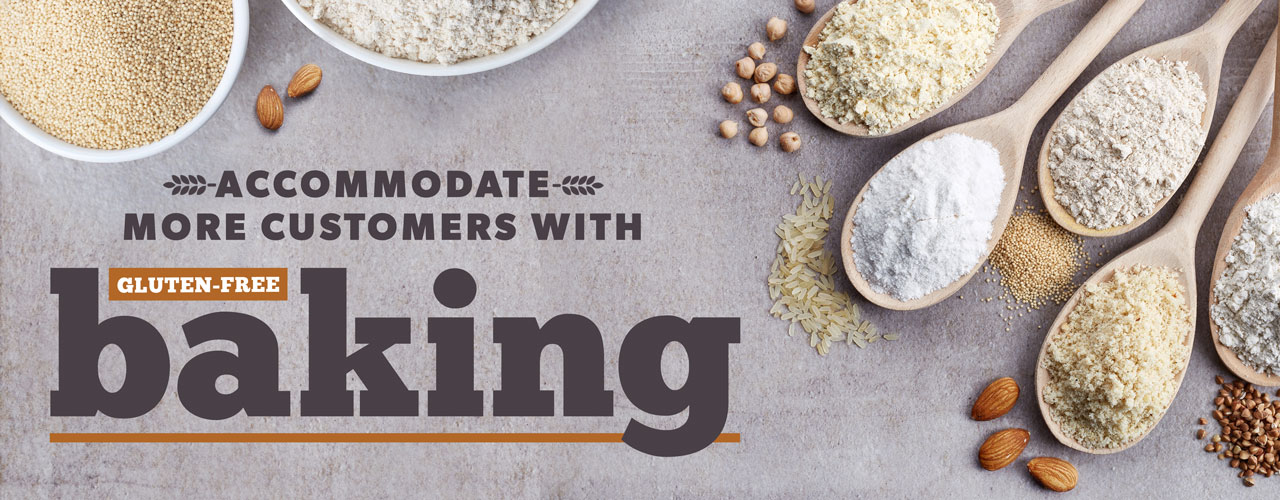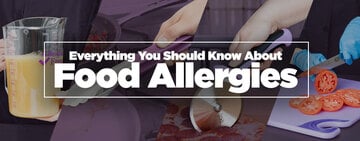
Have you ever been curious about why some people go gluten-free? As many as 3 million people in the United States are diagnosed with Celiac disease. Those who have this disease cannot eat and properly digest gluten products without harming their small intestine. As awareness of this disease has increased over time, owners of bakeries have started to accommodate their customers with this intolerance by adopting gluten-free baking operations. Not to mention, gluten-free diets for individuals without Celiac disease are growing in popularity, and you can capitalize on that by producing gluten-free goods. This being said, if you are interested in catering to customers with gluten-free diets, it’s important to have a basic understanding of gluten, Celiac disease, and how gluten impacts those affected by the disease.
Shop All Gluten-Free FoodsWhat is Gluten?

Gluten is the protein found in wheat, barley, rye, and other similar grains like triticale, a hybrid of wheat and rye. This protein acts as a binding agent, making batters and dough sticky and giving them their structure and shape. Gluten provides elasticity and stability, holding together cookies, cakes, pastries, and other favorite baked goods.
What is a Gluten-Free Diet?
A gluten-free diet completely exludes the use of gluten, and it may include gluten-free substitutes in order to enjoy traditionally glutinous foods. While a gluten-free diet is necessary for people with Celiac disease, many modern diet systems also recommend going gluten-free. For this reason, any gluten-free goods you produce will appeal to customers interested in these lifestyles and will also accommodate individuals diagnosed with Celiac disease.
What is Celiac Disease?
Celiac disease causes the body to be hypersensitive to gluten products. It occurs when the body’s natural defense system reacts to gluten by attacking the lining of the small intestine. If an individual with Celiac disease continues to eat gluten products, they can potentially ruin their healthy intestinal lining over time, which will cause the body to lose its ability to absorb the nutrients it needs. This can cause nutrient deficiencies, ultimately leading to other diseases like anemia, osteoporosis, diabetes, and intestinal cancers. As the owner of a bakery, it’s important to be extremely cautious and knowledgeable when baking gluten-free, since any cross-contamination can lead to harmful side effects.
Avoiding Cross-Contamination of Your Gluten-Free Baked Goods
The growing public awareness of gluten-free diets has made gluten-free bakery products more accessible than ever before. With many different types of gluten-free flours and other ingredients available on the market, bakers can offer delicious alternatives to your favorite glutinous goodies. However, there is always a risk for contamination with gluten.
If you offer both regular and gluten-free baked goods on your menu, there is a very high risk that gluten can accidentally be mixed into gluten-free batters. Gluten protein can linger in the air and contaminate your gluten-free products hours after you've baked with it. Even the slightest trace of this protein can cause discomfort and major complications for someone with Celiac disease. Your best option is to operate a 100% gluten-free kitchen that only offers gluten-free choices. If this is not possible for your business, consider the following tips for avoiding cross-contamination:
- Use separate tools and equipment and complete all of your baking in a partitioned, gluten-free area. Designate food allergy safety products that are only used for preparing gluten-free foods. Wash and store them separately from other utensils, as well. You should also use a different oven for baking these products.
- Research your ingredient suppliers. If an ingredient isn't certified gluten-free, don’t trust it. It is also important to be well-informed of the processing and packaging used for your gluten-free flour. If the mill also supplies regular wheat flour, there’s a risk of contamination. Look for labels on packages, and read the ingredient lists on everything, including your mix-ins and toppings.
- If your bakery offers both gluten-free and gluten-full options, be sure to clearly mark which products are safe for your gluten-intolerant customers.
Using Gluten-Free Ingredients in Your Bakery
There are many gluten-free baking ingredients you can use to replace ingredients containing gluten, but working with them may take some practice. Since gluten-free cakes, cookies, and other treats lack the protein that gives them the fluffy and sticky texture that many people enjoy, it’s important to learn how to make up for the lack of gluten. Here are some guidelines for adopting gluten-free ingredients:
- By adding in other starches and ingredients like baking soda and baking powder, you can achieve a texture similar to that provided by gluten. Be sure that you are using gluten-free baking powder and baking soda before making this substitution.
- Mix different gluten-free flours to find the right combination for your recipe. Each type of gluten-free flour has its own characteristics, so if you combine their various qualities into a single blend, you can improve the texture, flavor, and structure of your baked goods. Additionally, you can find gluten-free baking mix with pre-blended ingredients.
- Add xanthan gum for stretchiness. Using small amounts of xanthan gum in your gluten-free baking will help mimic the stretchy quality of dough for breads and pastries. A general rule of thumb is to add 1/2 teaspoon of xanthan gum per 1 cup of gluten-free flour for cakes, muffins, and quick breads. For cookies and bars, add 1/4 – 1/2 teaspoon of xanthan gum per 1 cup of gluten-free flour.
- Add more eggs. Eggs have a lot of protein, which allows them to act as a binder, resulting in baked goods that won’t crumble. Beating egg whites can increase the volume of your batters, while adding an extra egg yolk can add tenderness and help enhance texture.
- Check and see if some of your favorite products are already gluten-free. Some common ingredients like pure cocoa powder and cornstarch typically do not contain gluten. If you can ensure that they have not been contaminated in processing or contain gluten-full additives, then these ingredients can be safe to use without substitution.
Different Types of Gluten-Free Flour
There are several different types of grains, nuts, beans, and root vegetables that can be processed into gluten-free flour. Below, we’ve offered you a list of flour options that you can use for baking gluten-free products.
Almond Flour
Almond flour is a flavorful, low carbohydrate substitute for glutinous flour. Made from skinless, blanched, and ground almonds that are milled to a very fine consistency, this flour is light and adds moisture and protein to baked goods. Due to its texture and flavor, almond flour is ideal for breads, macarons, cakes, pastries, and pie crusts. Its naturally nutty flavor is also complementary to a variety of baked goods, and it can be used in place of bread crumbs for many recipes.
Rice Flour
Rice flour is a great gluten-free substitute for all-purpose flour, and it also serves as an alternative to wheat flour. Made from milled and polished white rice, this low-fat flour is ground to a fine consistency, resulting in a smooth texture. It’s also light and mild, making it great for many delicate desserts, and it is perfect for thickening puddings and custards. You can even find rice flour made from ground brown rice for even more nutritional value.

Other Gluten-Free Flour Options for Baking
- Tapioca flour
- Teff flour
- Buckwheat flour
- Quinoa flour
- Coconut flour
If you're ready to open a gluten-free bakery, or you're looking to start offering gluten-free desserts in your establishment, be sure you understand all of the requirements that must be met. Remember, you must have completely separate tools and equipment designated for gluten-free baking. Once you've set up your kitchen and have bought the proper gluten-free baking supplies, you'll be on your way to making delicious baked goods for your gluten-intolerant customers.





